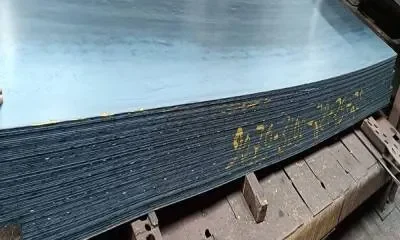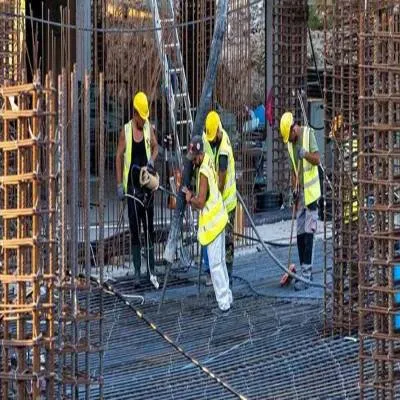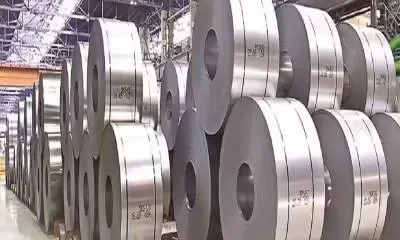Concrete
Building the Future
Published
2 years agoon
By
admin
In the rapidly evolving landscape of Indian infrastructure, specialised construction projects stand at the forefront of innovation and development. In this article, we look into the transformative role of cement as India builds its infrastructural dreams, ensuring they stand the test of time and contribute towards sustainable, economic growth.
Specialised construction projects encompass a diverse range of endeavours that demand unique expertise, advanced techniques, and tailored materials to address specific challenges and achieve exceptional outcomes. In India, these projects play a crucial role in shaping the country’s infrastructure and urban landscape, contributing to economic growth and societal advancement. Specialised projects include bridges, dams, metro rail systems, tunnels etc.
India is home to a multitude of bridges spanning rivers, valleys and urban landscapes. These structures vary in complexity and scale, from small pedestrian bridges to iconic cable-stayed bridges like the Bandra-Worli Sea Link in Mumbai or the Signature Bridge in Delhi. With its vast network of rivers and reservoirs, India relies on dams for water storage, flood control and hydroelectric power generation The metro rail systems are vital components of urban transportation infrastructure, providing efficient, sustainable mobility solutions for millions of commuters. Projects like the Delhi Metro, Mumbai Metro and Bengaluru Metro exemplify the integration of modern engineering and construction techniques in urban environments. Tunnels are essential for providing transportation connectivity through challenging terrain, such as mountains and dense urban areas.
ROLE OF CEMENT IN SPECIALISED CONSTRUCTION
Cement stands as the cornerstone of specialised construction projects, offering unparalleled versatility, durability, and strength crucial for these ventures’ success. Its significance lies in its ability to bind various construction materials together, providing structural integrity and longevity to complex infrastructures. Cement’s primary role in specialised projects extends beyond mere adhesion; its chemical and physical properties make it indispensable for a multitude of applications. Notably, its hydraulic properties enable it to harden and set underwater, making it indispensable for projects like dams and underwater structures.
Pritam Chivukula, Vice President, CREDAI-MCHI, and Co-Founder and Director, Tridhaatu Realty, says, “Developers look at the strength, durability, sustainability, local availability of materials and storage of these materials among other properties while selecting a product. It can affect the project and maintenance cost to a large extent. Strength is the most important aspect while selecting construction materials. It reveals the ability to withstand stresses such as compression, tension and shear. For instance, steel is graded according to its strength. If the building does not have to bear large loads, then low steel grade can be used and vice versa.”
“Durability helps in a structure with a long-life span without considerable maintenance cost. Sustainability helps in reducing the carbon footprint and addresses the industry and home buyer demand. Local availability of materials is important as it affects both the construction cost and schedule. Handling and storage of materials is another factor that must be considered because it affects construction time, requirements for labour and equipment for handling and construction cost,” he adds.
Furthermore, cement’s adaptability allows for the formulation of specialised mixes tailored to meet specific project requirements, whether it is achieving high compressive strength in high-rise buildings or enhancing durability in bridges subjected to harsh environmental conditions. Moreover, cement’s compatibility with various additives and admixtures facilitates the development of concrete with desired characteristics, such as rapid strength gain, self-healing properties, and resistance to chemical corrosion. In essence, cement serves as the bedrock of specialised construction, providing the foundation upon which monumental structures and infrastructures are built, ensuring longevity, safety, and resilience in the face of diverse challenges.
Prashant Sharma, President, NAREDCO, Maharashtra, says, “In choosing construction materials, developers focus on key attributes like strength for load bearing, durability against decay and weathering, cost-effectiveness, and environmental sustainability. Material weight influences structural design and engineering, while thermal properties affect energy efficiency and comfort. Fire resistance is crucial for withstanding high temperatures and enhancing building safety.”
TYPES OF CEMENT USED
In the realm of specialised construction projects in India, a diverse array of cement types finds application, each tailored to meet specific project requirements and environmental conditions. Portland Cement serves as the backbone of many projects due to its versatility and reliability, delivering high compressive strength and durability ideal for various applications ranging from high-rise buildings to bridges and dams. Blended cements, such as Portland Pozzolana Cement (PPC) and Portland Slag Cement (PSC), are gaining prominence for their enhanced performance and sustainability benefits. PPC, incorporating pozzolanic materials like fly ash, offers improved workability, reduced heat evolution, and increased resistance to chemical attack, making it suitable for marine structures and underground constructions. PSC, blended with granulated blast furnace slag, exhibits superior resistance to sulfate and chloride attacks, making it an ideal choice for structures exposed to aggressive environments, such as coastal areas and industrial sites.
Moreover, specialty cement formulations, including High-Early Strength Cement (HESC), Low-Heat Cement (LHC), and Sulphate-Resistant Cement (SRC), address specific challenges encountered in specialised projects while contributing to sustainability efforts by reducing carbon emissions and resource consumption. Engineered cementitious materials like Self-Compacting Concrete (SCC) and High-Performance Concrete (HPC) offer superior workability, durability, and mechanical properties, further advancing sustainability goals in the construction sector.
“To curb sustainability issues, adopting alternative materials to traditional cement is crucial for reducing its usage, enhancing production efficiency, and leveraging concrete carbonation to lower emissions. Innovations in concrete mixtures with reduced cement content or carbon capture technology are essential. Sustainable design principles that reduce material use and incorporate natural resources also lessen the construction industry’s environmental footprint. Furthermore, utilising Building information modelling (BIM) improves material specification accuracy, minimising over ordering and construction waste. For instance, fly ash is a byproduct of burning pulverised coal in electric power generating plants. There are multiple advantages like the cement content can be reduced by 25 per cent by mixing ash in the concrete. This concrete mix generates low heat of hydration. It also reduces requirements of clay, sand, limestone in cement manufacturing and hence conserves natural resources,” says Sharma.
“Secondly, autoclaved aerated concrete (AAC) blocks, being 3 to 4 times lighter than traditional bricks, simplify and lower transportation costs.
Their lighter weight reduces a building’s structural load by up to 60 per cent, allowing for more design flexibility and less reinforcement. AAC blocks offer high fire resistance, improving a building’s fire safety. Their production is more sustainable, generating less waste and using fewer resources, and they are environmentally friendly due to their non-toxic materials and lower energy consumption. The quick construction benefits of AAC blocks make them ideal for fast-paced projects without sacrificing quality or durability,” he adds.
By leveraging this diverse range of cement types, specialised construction projects in India can achieve optimal performance and durability, meeting the evolving needs of the built environment while ensuring the success and longevity of monumental undertakings.
TAILORING CEMENT FOR SPECIALISED CONSTRUCTION
In specialised construction projects, cement formulations play a crucial role in meeting specific demands such as strength, durability, and environmental considerations. To achieve desired strength characteristics, engineers can modify cement compositions by incorporating supplementary materials like silica fume or metakaolin.
Durability can be enhanced through the use of blended cements containing pozzolanic materials or slag, which improve resistance to chemical degradation and reduce permeability. Moreover, advancements in admixture technology allow for precise control over concrete properties, ensuring tailored solutions for intricate architectural elements or logistical challenges during construction.
Additionally, innovations in cement chemistry aim to improve environmental sustainability by reducing carbon emissions and energy consumption associated with production. By continuously refining cement formulations, stakeholders can ensure that specialised projects meet structural, durability, and sustainability requirements, addressing the evolving needs of the construction industry.
ADVANCEMENTS IN CEMENT TECHNOLOGY
Recent technological breakthroughs have transformed cement’s role in specialised construction projects, enhancing performance and sustainability. High-performance concrete (HPC) offers superior strength and durability, crucial for challenging environments. Self-healing concrete, integrating microorganisms or encapsulated agents, autonomously repairs cracks, prolonging structural integrity.
Sustainable alternatives like fly ash and ground granulated blast furnace slag (GGBFS), coupled with carbon capture and utilisation (CCU) technologies, reduce the environmental impact of cement production. Digital tools like Building Information Modeling (BIM) optimise mix designs and construction processes, ensuring efficiency and quality. These innovations promise a future where specialised projects are not only robust but also environmentally conscious, meeting the demands of modern construction sustainably.
“The real estate sector in India is evolving and demand is growing for sustainable developments. This brings into play the need to increase the use of green and sustainable building materials in the construction process which has minimal impact on our environment and considerably lowers carbon footprint. These materials conserve natural resources, reduce waste and energy usage,” says Chivukula.
“One innovative approach gaining traction in the concrete industry is carbon capture and utilisation (CCU). This technology captures CO2 emissions from concrete plants and converts them into usable products. For example, captured CO2 can be chemically converted into calcium carbonate, which can then be used as an ingredient in concrete production. This not only reduces CO2 emissions but also improves the concrete’s strength and durability,” he adds.
FUTURE OUTLOOK
Looking ahead, the future of cement usage in specialised construction projects in India holds promising prospects, driven by emerging technologies, evolving market dynamics, and increasing sustainability considerations.
Emerging technologies, such as advanced concrete formulations and digital construction tools, are expected to revolutionise the way specialised projects are conceptualised, designed, and executed. High-performance concrete (HPC) and self-healing concrete will become increasingly prevalent, offering enhanced durability and resilience to structures. Furthermore, digital tools like Building Information Modelling (BIM) and real-time monitoring systems will enable greater efficiency, precision, and sustainability throughout the construction process.
Market dynamics are also evolving, with a growing emphasis on sustainable construction practices and materials. The demand for eco-friendly cement alternatives, such as fly ash, slag, and calcined clays, is expected to rise, driven by regulatory pressures and environmental consciousness among stakeholders. Additionally, the adoption of carbon capture and utilisation (CCU) technologies will play a crucial role in reducing the carbon footprint of cement production, aligning with global sustainability goals.
In conclusion, the future of cement usage in specialised construction projects in India hinges upon continuous innovation and collaboration within the industry. By embracing emerging technologies, market dynamics, and sustainability considerations, stakeholders can ensure that specialised projects meet the evolving needs of the construction sector while minimising environmental impact. Continuous innovation and collaboration will be paramount in driving the industry forward, ensuring that specialised construction projects in India remain at the forefront of excellence and sustainability.
You may like
-


LANXESS Advances Pigment Solutions for New-Age Concrete Technologies
-


Molecor Renews OCS Europe Certification Across Spanish Plants
-


Enlight Metals Enters Chemical Trading With New Subsidiary
-


From Grey to Green
-


Building a Safer, Smarter and Sustainable World
-


Product life is always a matter of innovation
Concrete
ICRA Sees Steady Cement Demand Growth Ahead
Volumes seen rising 6–7 per cent in FY27 on infra push
Published
3 days agoon
January 2, 2026By
admin
India’s cement industry is expected to record steady growth over the coming years, with cement volumes projected to expand by 6–7 per cent in FY27, supported by sustained demand from the housing and infrastructure sectors, according to a report by rating agency ICRA.
The agency said the sector is likely to maintain healthy momentum after registering growth of 6.5–7.5 per cent in FY26, despite a higher base in the second half of FY25. Cement demand remained strong in the current financial year, with volumes increasing by 8.5 per cent during the first eight months of FY26, driven by robust construction activity across regions.
ICRA expects demand to strengthen further in the second half of FY26 as construction activity accelerates after the monsoon. Continued government focus on infrastructure spending and the possibility of a reduction in goods and services tax on cement are also expected to support demand through FY26 and FY27.
Against this favourable demand backdrop, cement manufacturers are continuing to expand capacity through both organic and inorganic routes to strengthen their market positions. The industry is estimated to add 85–90 million tonnes per annum of capacity during FY26–FY27, including around 43–45 million tonnes per annum in FY26 and a further 42–44 million tonnes per annum in FY27.
Commenting on the outlook, Anupama Reddy, Vice President and Co-Group Head, Corporate Ratings at ICRA, said sector profitability is expected to improve significantly in FY26, supported by better pricing and higher volumes. Operating profit before interest, depreciation, tax and amortisation per tonne is projected to rise to around Rs 900–950 per tonne in FY26, compared with Rs 810 per tonne in FY25.
However, ICRA expects some moderation in earnings in FY27 due to rising input costs. Operating profit per tonne is estimated at Rs 880–930 in FY27, as costs related to pet coke and freight are likely to increase and remain influenced by global crude oil prices and geopolitical developments.
On a regional basis, North and Central India are expected to report capacity utilisation levels above the national average, while the southern region may continue to see relatively moderate utilisation due to existing capacity overhang. ICRA noted that recent merger and acquisition activity in the southern market has helped large players strengthen their regional and pan-India presence.
Overall capacity utilisation for the cement industry is projected to remain stable at around 70–71 per cent in FY27, broadly in line with FY26 levels, albeit on an expanded capacity base.
Concrete
GCCA India–NCB Carbon Uptake Report Released at NCB Foundation Day
New report highlights CO? absorption by concrete in Indian conditions
Published
1 week agoon
December 29, 2025By
admin
The Global Cement and Concrete Association (GCCA) India–NCB Carbon Uptake Report was recently released during the 63rd Foundation Day celebrations of the National Council for Cement and Building Materials (NCB). On the occasion, a Gypsum Board Testing Laboratory and a Micro-Characterisation Laboratory were also inaugurated, strengthening India’s research and quality infrastructure for construction materials.
The laboratories were inaugurated by Urmila, Economic Advisor, Department for Promotion of Industry and Internal Trade (DPIIT), and Mohd. Kamal Ahmad, Special Director General, Central Public Works Department (CPWD), in the presence of L. P. Singh, Director General, NCB.
The newly established Gypsum Board Testing Laboratory will support quality assurance and standardisation requirements of the gypsum board industry, particularly in the context of the Gypsum-Based Building Materials (Quality Control) Order, 2024. The Micro-Characterisation Laboratory is equipped with advanced analytical tools for detailed investigation of cementitious and construction materials.
Addressing the gathering, Ms Urmila highlighted NCB’s sustained contributions to research, technology development, quality assurance and capacity building for the cement sector. Shri Mohd. Kamal Ahmad also commended NCB’s role in promoting sustainable construction practices through focused research and development.
The GCCA India–NCB report titled Carbon Uptake by Concrete assesses CO? uptake through carbonation in concrete under Indian conditions. Prepared in collaboration with the Global Cement and Concrete Association (GCCA) India, the study is based on the Tier-I methodology of IVL Swedish Environment Research Institute. It notes that while the cement industry contributes around seven per cent of global anthropogenic emissions, carbon uptake by concrete can partially offset process-related emissions.
The report outlines future actions to improve data robustness, refine estimation methodologies and support integration of carbon uptake into national sustainability and climate reporting frameworks. It will be submitted to the Ministry of Environment, Forest and Climate Change for consideration of inclusion as a carbon sink in India’s National Communications to the UNFCCC.
Concrete
Shree Cement To Invest Rs 20 Billion In Maharashtra Plant
New 2 mtpa unit to strengthen capacity expansion plans
Published
2 weeks agoon
December 24, 2025By
admin
Shree Cement Ltd has announced an investment of Rs 20 billion to set up a new cement plant in Maharashtra, the country’s third-largest cement maker said on Friday at the World Hindu Economic Forum (WHEF) 2025. The letter of intent for the proposed investment was signed in the presence of Maharashtra Chief Minister Devendra Fadnavis in Mumbai. Shree Cement chairman Hari Mohan Bangur said the company will establish a 2 million tonnes per annum plant in Chandrapur district, where land has already been acquired. He added that the project is awaiting environmental clearance and, once approved, is expected to be completed within two years. The expansion will be funded through internal cash reserves, with the company reporting a cash balance of Rs 65.41 billion at the end of FY25.
Shree Cement currently has an installed capacity of 62.8 million tonnes per annum. During the second quarter of FY26, the company commissioned a 3.65 mtpa clinker unit at Jaitaran in Rajasthan, while a 3 mtpa cement mill at the same location is expected to start operations shortly. A 3 mtpa integrated plant at Kodla in Karnataka is in the final stages of development and is scheduled to be commissioned within the third quarter of FY26. Following these ongoing expansions, the company’s total capacity is expected to rise to 68.8 mtpa, according to an ICICI Direct Research note dated 29 October.
Analysts estimate that Shree Cement’s capacity could reach between 72 and 75 mtpa by FY27E, with further potential to scale up to 80 mtpa by FY28E or FY29E, depending on demand trends. However, market observers have flagged medium-term risks, noting that industry-wide capacity additions may outpace demand growth through FY28-29, particularly in northern and western India where significant new capacity is expected. At the same time, cement prices declined sharply in the third quarter, especially in eastern and southern regions, though analysts expect some recovery from January, led by the South and East.
The announcement comes amid aggressive expansion plans by larger peers. UltraTech Cement recently raised its capacity target from 167 mtpa to 240 mtpa by FY28, while the Adani Group increased its cement capacity target by nearly 10 per cent to 155 mtpa by the same period. Shree Cement reported a 15 per cent year-on-year rise in revenue to Rs 43.03 billion in the September quarter, driven by higher volumes, premiumisation efforts and a value-over-volume strategy. The company’s chief financial officer Ashok Bhandari has guided for capital expenditure of around Rs 30 billion in FY26-27, with a similar level expected in FY27-28. Shares of Shree Cement ended 0.18 per cent lower on Friday, while the benchmark Sensex closed 0.53 per cent higher.

ICRA Sees Steady Cement Demand Growth Ahead

India Imposes Three-Year Tariff on Select Steel Imports

GCCA India–NCB Carbon Uptake Report Released at NCB Foundation Day

Global Crude Steel Output Falls 4.6% to 140.1 Mt in Nov 2025

Shree Cement To Invest Rs 20 Billion In Maharashtra Plant

ICRA Sees Steady Cement Demand Growth Ahead

India Imposes Three-Year Tariff on Select Steel Imports

GCCA India–NCB Carbon Uptake Report Released at NCB Foundation Day

Global Crude Steel Output Falls 4.6% to 140.1 Mt in Nov 2025

Shree Cement To Invest Rs 20 Billion In Maharashtra Plant
Trending News
-

 Uncategorized3 weeks ago
Uncategorized3 weeks agoNMDC Steel Posts Record Output And Efficiency Gains In November
-

 Concrete4 weeks ago
Concrete4 weeks agoNiraj Cement JV Wins Railway and Metro Contracts
-

 Uncategorized3 weeks ago
Uncategorized3 weeks agoLloyds Metals, Tata Steel Sign MoU For Strategic Partnership
-

 Uncategorized3 weeks ago
Uncategorized3 weeks agoEnlight Metals Enters Chemical Trading With New Subsidiary


